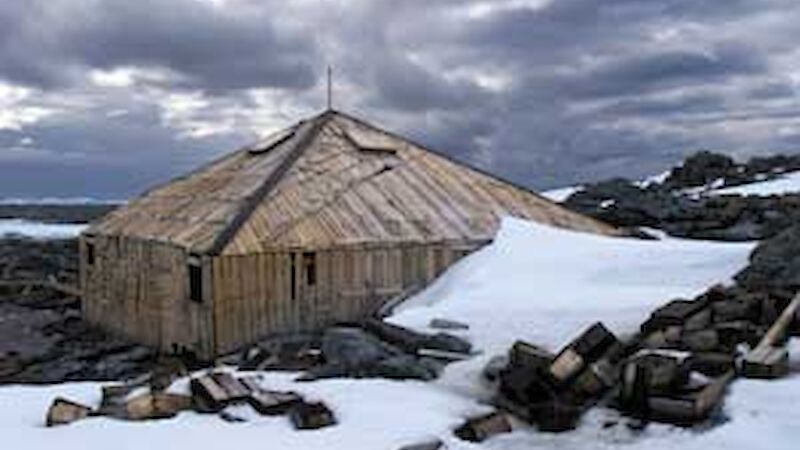Sir Douglas Mawson’s home in the blizzard — at Cape Denison, in the eastern sector of the Australian Antarctic Territory — will receive some much-needed repairs this season with the arrival of a team of heritage specialists at the site in late October.
Built and occupied by Mawson’s Australasian Antarctic Expedition (AAE) of 1911–14, the wooden living quarters and conjoined workshop have national and international heritage significance as one of just six complexes surviving from the ‘heroic era’ of Antarctic exploration, and as the foundation of the modern Australian Antarctic science program.
Over the years the Main Hut has borne the brunt of the extreme climate. Its Baltic pine tongue-and-groove roof was not adequately sealed during its construction, and ferocious katabatic winds have further worn away the boards, blasting snow and ice into the Hut. During warmer spells the accumulated snow and ice in the ceiling cavity has melted and run down the walls and onto the floor, saturating AAE artefacts including equipment, books, magazines, bedding, clothing and other personal items. In winter the refrozen melt water entombed the timbers and artefacts in ice as hard as concrete.
The Mawson’s Huts buildings are on the Register of the National Estate and their inclusion on the Antarctic Treaty list of Historic Monuments means that the AAD, as owner of the site, is obliged to ensure that the historic structures are not destroyed. This season’s expedition to Cape Denison comprises a heritage architect, two specialist carpenters, a materials conservator and an archaeologist, who will conduct vital conservation works including:
- structural investigation of the building foundations
- excavation of some compacted snow and ice from the interior of the living quarters and workshop
- patching of the living quarters’ roof and south-facing walls to stop snow, ice and melt water from entering
- repair of broken rafters and collar ties in the workshop roof
- installation of a variety of sensors inside the hut to monitor the internal environment, including temperature, relative humidity, salt ingress and corrosion
- documentation of historical artefacts inside and outside the living quarters and workshop
- preservation of those artefacts currently under threat of destruction by the effects of snow ingress and the freeze/thaw cycle
All work will be conducted in accordance with the site’s Conservation Management Plan, endorsed by the Federal Government in February 2002, and a Conservation Works Plan specially developed for this expedition by heritage consultants Godden Mackay Logan. The Works Plan was referred to the Minister for the Environment and Heritage in accordance with the Environment Protection and Biodiversity Conservation Act 1999. The Works Plan is designed so that the living quarters and workshop will be stabilised to a point that no major work will be required for several years.
Returning to Hobart in late December, the expedition marks the latest in a series of programs to ensure the stability and integrity of the Huts. Since 1996, four expeditions (organised by the AAP Mawson’s Huts Foundation and the AAD) have achieved structural repairs, re-clad the workshop roof, and repaired the skylights, roof capping and valley gutters between the two roofs to reduce the ingress of snow and ice. In 1997 the Foundation sponsored the installation of monitoring equipment which has produced enough temperature and humidity data to enable specialists to assess the likely effects of the environment on the aging structure and artefacts. The 2000–01 expedition removed non-heritage waste left by work parties since Mawson’s last visit in 1931, helping to re-establish the setting of this historic landscape. Throughout all of the expeditions an archaeologist has continued to document the rich collection of artefacts Mawson and his men left behind.
The 2002–03 expedition will travel to and from Cape Denison on the French re-supply vessel l'Astrolabe. The improved access to the site, located approximately 2560km south of Hobart, is due to a new cooperative agreement with the Institut Polaire Français Paul Émile Victor (IPEV) and will allow closer monitoring of the Huts. Nevertheless, the isolation and extreme weather conditions means the management of Australia’s most valuable Antarctic heritage asset remains a costly and challenging exercise.
The nine-member expedition team, led by experienced station leader Diana Patterson, will have about eight weeks in which to carry out the program in what will at times be hurricane conditions. Eight expeditioners will be deployed and retrieved by helicopters jointly chartered by the AAD and IPEV, while a ninth will be delivered in early December by the Russian icebreaker Kapitan Khlebnikov — weather permitting — to complete an environmental assessment of the site for its nomination as an Antarctic Specially Protected Area. The team will live in a prefabricated hut specially erected to support maintenance teams and scientists, but at least four members will stay in tents in the lee of the hut to protect them from the katabatics.
The expedition’s busy program will be supplemented by the arrival of tourists from the Kapitan Khlebnikov. Team members will guide the tourists around the site and through Mawson’s living quarters and workshop, providing them with an unusual and invaluable opportunity to understand expedition life not only of the AAE but also their modern-day equivalents. Knowledge of the site and its inhabitants will be further developed in the months after the expedition with the creation of an archaeological database. This, together with the environment monitoring data, will provide a vital resource for continuing research and effective conservation management of this icon of Antarctic heritage.
Rob Easther,
Mawson’s Huts Program
Manager,
&
Stephanie Pfennigwerth,
Environmental Management and Audit Unit, AAD

